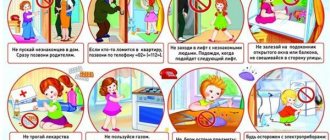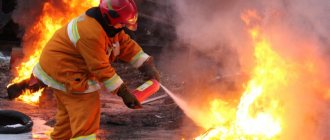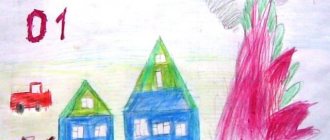Children's Art School No. 6
The main thing that children should know is that safe games are possible only on a specially equipped playground. The task of parents is to monitor the absence of dangerous objects and the serviceability of the equipment, teach children the rules for using it, explaining along the way how not to play :
To review the material, do a practical exercise . Discuss the proposed options with the children and choose which child chose a safe place to play (there may be several correct answers):
Cars deserve special attention. It's no secret that many courtyards have been turned into surface parking lots - this is an additional source of danger:
- cars can drive into the playground - we urge parents to stop these offenses by all legal means
- a child may be in a hurry to go home or to the playground and not notice a car driving along the yard - teach children not to rush, set the right example with your own behavior
- there may be parked cars near the entrance blocking the view of the roadway - this is also an offense, but parents also need to be vigilant and teach children to carefully inspect the roadway in order to notice a moving car, motorcycle, or bicycle in time
And, of course, we ask, first of all, the parents-motorists themselves not to create emergency situations in the yard!
To review the material, do a practical exercise . Look at the picture and discuss why there is a threat to the safety of children in the circled areas, ask your child to explain how these dangers can be avoided:
A special place in the conversation about personal safety should be given to leaving the house :
- before leaving the apartment (house), look through the peephole and make sure that there are no strangers on the site (near the door), otherwise wait;
- never enter an elevator with strangers, as well as into an entrance or landing if there are suspicious people standing there, especially a group of people;
- if you are attacked in the elevator, try to press the “Call dispatcher” button, but do not shout, especially in cases where you are not sure that there are people nearby who can help;
- Never, under any circumstances, get into a car, motorcycle, or helicopter with strangers!
If a child walks in the yard on his own, he needs to know several rules of safe behavior :
- stay away from teenagers who are older than you, are under the influence of alcohol or drugs, gamble or behave inappropriately
- do not take expensive things (cassette recorder, toys, tablet and other gadgets) outside if there are no elders near the house
- do not carry valuables or money with you
- do not climb in basements, attics and roofs
- when walking on the street, try to stay close to your home, be in familiar company (the last condition is mandatory if you go far from home, especially to a foreign area, to a disco, market, store, concert - in this case, you need adults to know , where are you at)
- a call for help is not evidence of cowardice, but a necessary means of self-defense, sometimes salvation
- if you are trapped - there are more attackers, they are clearly stronger, there is no one nearby who could come to the rescue - then it is better to give the money or the thing that they demand, remember that your life and health are most valuable
- if they start following you, go (run) to where there are a lot of people, there is more light (at night)
- never gamble, especially for money, with older children or adults, or with strangers in general
- In order to prevent kidnappings, it is necessary to:
- try not to be alone, especially on the street, on the way to school and back, from places of leisure;
- change your routes to school, the store, to friends, etc. more often.
- never talk to strangers, much less suspicious people;
- do not get into other people's cars, do not ride with strangers;
- always inform your relatives about where and when you are going, with whom, how long and where you are going to be, when and in what way you are going to return (if possible, provide your phone number and other coordinates where you can be found).
Content:
- General winter safety rules: a reminder for parents and children Rules of behavior on the street and on the road
- Winter on the pond
- Ice and icicles
- How long to walk with a child in winter
- Skiing, snowmobiling
- First aid for injuries
Memo for parents: teaching children to be observant on the street
If a child is consistently taught the rules of safe behavior on the street from early childhood, then, over time, he will follow them reflexively.
Fire safety for children: a reminder of what to do in case of fire
Three basic rules for safe behavior with strangers
Children should learn several basic rules of behavior with strangers:
- Do not engage in conversations with strangers and do not let them into the house in the absence of parents or other adults living in the same apartment with the child.
- Do not enter or be in the entrance or elevator car with strangers.
- Do not make physical contact with a stranger, get into their car, or respond to any offers of gifts.
Important! Don't linger outside after dark.
Rules for safe behavior in nature for children
When outdoors, children should follow a few simple rules to avoid threats to their health:
- Do not touch or, especially, do not put unfamiliar plants in your mouth. Contact with some plants can cause serious harm to health.
- Do not touch or pick up unfamiliar mushrooms or berries. Any collected mushrooms, berries or nuts, even those known to the child, must first be shown to an adult and only after his approval can they be eaten.
- Do not drink water from any natural sources. Drink only bottled water that you bring with you.
- In hot and muggy weather, do not stay in direct sunlight for a long time to avoid heat stroke.
You have to be on alert in the forest
When going outdoors, parents should also remember a few important rules:
- Children should be dressed in long sleeves and pants or jeans that completely cover their legs. Be sure to wear a hat on your child. This is necessary to minimize the threat of bites from ticks, mosquitoes, and other insects.
- The child should be sprayed and smeared in open areas with insect repellents.
- Do not leave behind open fires, garbage, or cause other harm to nature.
Knowing the rules of safe behavior with strangers can save the life and health of a child, so teaching these rules is not only the responsibility of parents, but also of every significant adult in his life: grandparents, educators, teachers. These rules should begin to be taught in preschool institutions and continue until graduation.
For each age (preschooler, elementary school student or high school student), you need to choose the most accessible form of learning for them (game, notes, presentation). A playful form of presenting material is suitable for kindergarten. For children of primary school age, special education on safety rules is required. For high school students, periodic reminders of the rules in the form of presentations during class hours.
How often should children be reminded of safety rules?
Classes should be held regularly, from once a week for kids, to once a quarter before the holidays for high school students. Regular repetition (but not in a stressful environment) will allow children to react reflexively in case of danger.
Providing safety, supervision and protection are the primary responsibilities of adults towards children. Childhood is the most vulnerable period for the psyche, when it is developing and all the psychological trauma received in childhood can leave an imprint on the rest of life.
First aid for injuries
If a child falls and hits himself, the first thing to do is take him to a quiet place and ask him where and how it hurts. If you feel well and have normal movement of the limbs, a bruise is possible, which is treated with rest for the first two days, and then with warming. In any case, monitor your child’s condition: if your health worsens, consult a doctor.
Don't hesitate to call an ambulance if:
- the child hurt his head;
- you suspect that the child may have a dislocation, sprain or fracture;
- The child complains of abdominal pain.
Do not undress the child and do not apply a splint to avoid frostbite in addition to injury. The exception is severe bleeding, which must be stopped with a tight bandage while waiting for the doctor.
Signs of frostbite and first aid
Frostbite, contrary to popular belief, occurs not only in the cold, but also when the air temperature is near zero, if there is a strong wind outside.
Signs of frostbite:
- the affected area of the body loses sensitivity;
- the skin turns red and there is a tingling sensation;
- If measures are not taken in time, blisters appear.
If you notice signs of frostbite in a child, immediately take him indoors. Place the affected part of the body in warm water, then rub the skin to restore sensitivity.
Walking in winter: what you need to know
A safe winter walk begins at the door of your home. Prepare for going outside with your children in advance:
- feed your child a nutritious meal - much more energy is spent in the cold than in the warmth;
- make sure that the child is fully dressed (fastened the zippers, put on a hat and mittens) before going out the door;
- explain that during games you should not push other children too much, especially those who are younger and weaker;
- Warn your child about the danger of jumping into a snowdrift, where anything can be hidden: fragments, debris, sharp stones.
Advice to parents. Teach children to fall correctly: on their side, bending their knees and trying to soften the fall with their hands. Tell them that falling on your back or forward on your hands can lead to serious injury.
How long to walk with a child in winter
Table-memo for parents about the duration of a winter walk with a child at an air temperature of at least -15° C:
| Child's age | Walk duration |
| Up to 1 year | 1-1.5 hours |
| 1-2 years | 1-2 hours |
| 2-4 years | 1.5-3 hours |
| More than 4 years | 2-4 hours |
⠀
It would be reasonable to shorten the walking time if the temperature outside drops below -15° C. It is better to divide the total walking time with a child under 4 years old into 2-3 separate trips outside, for example, in the morning, afternoon and evening. For children with a cold, it is better to refrain from walking during the height of the illness and reduce the time they spend outside when the child is already on the mend.
To what temperature do they walk with children in winter?
Pediatricians recommend walking with babies under 6 months at an air temperature of at least -6° C. With older children, 6-12 months, you can go outside if the thermometer shows -10° C. With a child over a year old, long walks are acceptable - longer than 1 hours - walks at an air temperature of at least -15° C, if the baby walks well and moves actively on the street. Active children over 5 years old can walk even at -20° C, if it is sunny and windless outside.
Advice to parents. When setting the minimum permissible air temperature for a walk with a child, take into account the characteristics of your region. Children will tolerate even a fairly low temperature with low humidity more easily than a higher temperature, but also with high humidity.
The right clothes
What you need to know when dressing your children for a winter walk:
- Do not dress your child too warmly “just in case” - overheating is no better than hypothermia. Put on your son or daughter the same number of layers of clothing as you would put on yourself, or one layer more if you are going for a walk with a baby under one year old.
- Choose loose clothing that does not restrict movement.
- Make sure that the first layer of clothing your child wears is made of synthetics or wool. Cotton gets wet quickly on a sweaty body and dries very slowly.
- Make sure your child wears shoes that fit properly—tight shoes can put your feet at risk of frostbite.
- In winter, it is recommended to wear mittens on your hands - they retain heat better than gloves. If the child is small, sew an elastic band to the mittens so that the baby does not accidentally lose them.
Frostbite and injuries: first aid for a child
Parents often think that only careless adults can deal with frostbite and injuries. This is not true: doctors note that every winter children from wealthy families who were not careful enough during walks arrive with various injuries and symptoms of frostbite. Learn to provide first aid for frostbite and injuries - and if necessary, you will be able to help your child in an emergency without panicking.
Winter fun and children's safety
Each winter fun has its own characteristics. But there are also general safety rules during children’s games that will be useful for your child to know:
- you cannot take off your hat and scarf, even if there is a deceptive feeling of warmth or other children consider the clothes “unfashionable”;
- tell your child that if he feels that he is freezing or gets his feet wet, he needs to immediately return home and immediately change into dry clothes;
- if for some reason a frozen child cannot immediately enter a warm room, let him not stop moving to stimulate blood circulation;
- any games should take place away from the roadway.
Skiing, snowmobiling
Skiing and snow scooters are one of the safest winter activities. Under adult supervision, children learn to ski from the age of 4-5.
How to choose skis for a child: according to height, age and level of training.
Safety rules for young skiers and their parents:
- for skiing, choose a not very steep hill, preferably in a park or in a place where there is no traffic;
- Wear a protective helmet on your child if you plan to ride on public slides where there is a risk of colliding with other skiers;
- dress your child in a bright suit - so he will be visible on the slope;
- if the child has never skied before, first just teach him how to ski;
- A beginner skier does not need ski poles; without additional support, he will quickly learn to maintain balance.
Advice to parents. When heading out on the slopes with your child, bring extra gloves, water and a snack.
Snow scooters are similar to sleds, with skis instead of runners. Well managed, but require their own security measures:
- choose a smooth hill for riding with your child without large obstacles (rocks, trees) on the descent;
- show your child how to control a snow scooter using the steering wheel and brake;
- help lift the snow scooter to the top of the slide if it is difficult for the child to cope on his own.
Snow scooters weigh on average about 6 kg; it will be difficult for a preschool child to control them. Starting from primary school age, children handle snow scooters quite confidently.
Ice skating: behavior on ice
The main condition for safe skating is the choice of a specially equipped skating area. You can put your child on ice for the first time as early as 3 years old. Other ice rules:
- Always wear a protective helmet, knee pads and elbow pads on your child;
- To go to the skating rink with a beginner skater, choose a time when there are few other people on the rink: relative desertedness will help avoid injuries;
- try to always be nearby to help the child if necessary;
- for the first time on the skating rink, limit yourself to walking from one edge of the skating rink to the other with a side step;
- Teach your child the correct fall technique: group and fall on your side.
Advice to parents. Choose skates that are half a size larger than your child’s shoes.
Slides: safety precautions
When choosing a slide for your child to ride, pay attention to its safety. There should be no roads or bodies of water near the hill. If you are taking a small child for a ride, then a crowd of active teenagers on the slide is also a potential danger.
What children and parents need to know - safety precautions on the slide in winter:
- remind your son or daughter that politeness is good everywhere, and on the slide too: let the child give way to the younger ones and respect the riding line;
- Monitor your child’s ride, especially if he is still small and there are many other children on the slide;
- Children under 5 years old should only be allowed to ride down gentle slopes;
- Before going up the hill, put your child on non-slip shoes;
- Allow your child to ride only on a skating device - an ice skate, a cheesecake, a snow scooter, but not on his feet or squatting.
Advice to parents. If your child is under 5 years old, do not buy him a trough-shaped ice skate - such skating devices are quite difficult to control.
Sleds, ice skates and tubing: what you need to know
Sleds, ice skates and tubes are equally well suited for sledding, but differ in some characteristics, including the degree of safety. The safest device for descending is a sled; tubes are the most difficult to control. Ice boats are good for their lightness and low price, but they are a little inferior to sleds in terms of safety - it is more difficult to control an ice boat than a sled.
How to make ice skating safe:
- for smooth ice slides, simple oval ice cubes with one handle are suitable; for snowy slopes, plate ice cubes or trough ice cubes with two handles and recesses for the feet;
- do not use ice cubes in the shape of a plate or trough on ice slides - on a slippery surface such ice cubes become uncontrollable;
- For ice skating, choose only smooth slides, without springboards, to avoid back injury.
Rules for safe sledding:
- if the child is under 5 years old, choose a slide without a steep descent;
- remind your child that during the descent you need to hold on tightly to the sled with your hands;
- Tell your child that you cannot sled while standing, lying down or sitting against the movement.
Precautions when riding cheesecakes (tubing):
- Slides that are not too steep are suitable for tubing - the tubes are light and the child may not be able to control them;
- Explain to your child that a collision with other children on the tube can lead to injury - let him roll on the tube when the risk of colliding is minimal;
- Be close to the slide if you come to ride the cheesecake with a small child.
A child can learn to operate an ice cube at the age of 3, a sled at the age of 4, and a cheesecake at the age of 6.





